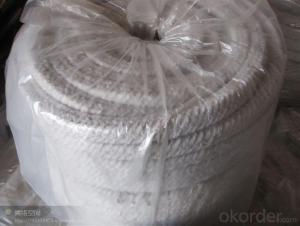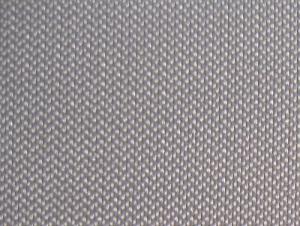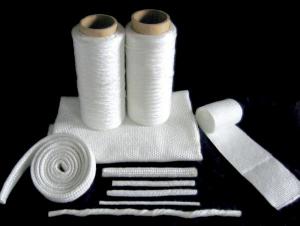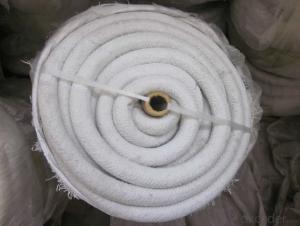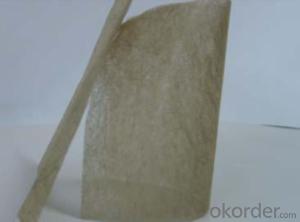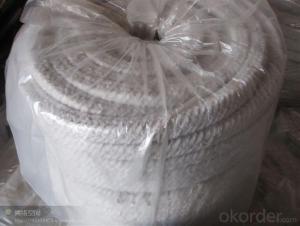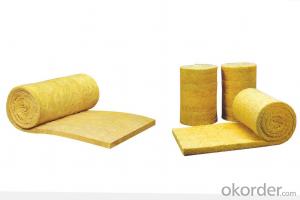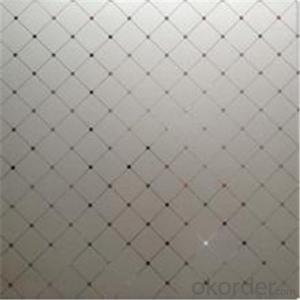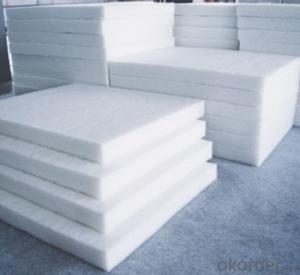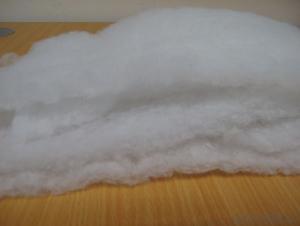Fire Ceramic Fibre Round & Square Ropes 2015
- Loading Port:
- Shanghai
- Payment Terms:
- TT OR LC
- Min Order Qty:
- 10 m.t.
- Supply Capability:
- 100 m.t./month
OKorder Service Pledge
OKorder Financial Service
You Might Also Like
Quick Details
| Place of Origin: | China (Mainland) | Application: | Refractory | Working Temperature: | 450,1000,1260 |
| Fiber Diameter: | 15,20 | Model Number: | Fabric,Round woven rope, | Organic content: | ≤15 |
| Bulk Density (Kg/m3):: | 500±30 |
Packaging & Delivery
| Packaging Detail: | pp woven bag or carton box |
| Delivery Detail: | 25days |
Specifications
high quality bio soluble ceramic blanket
Specifications
Fine tensile strength
Fine high-temperature strength
Good at heat insulation
Low heat conduction ration
Fine tensile strength
Fine high-temperature strength
Good at heat insulation
Low heat conduction ration
PROCESSING:
Fibre Sennit: It includes core rope and outer warp. The core rope contains aluminosilicate fibre yarn and blanket strip etc. The outer wrap is weaved by using glass fibre or refractory alloy silk according to temperature and condition used.
Fibre wringed rope: It is wringed by multilayer aluminosilicate fibre silk which are strengthen by glass fibre and refractory alloy silk.
Fibre quit: It is bound up by glass silk fibre fabric using aluminosilicate disperse cotton as raw material. According to temperature and condition used, it can be used at the condition which can not be used by other aluminosilicate products.
TECHNICAL SPECIALITY:
Good heat resistance. The ceramic fibre fabric, which strentgth is increased by refractory alloy silk , can be used at 1000°Ccontinuously.
High quality of antacid, oil resistance and water vapor resistance
High quality of electric insulation
Fine tensile strength
Fine high-temperature strength
Good at heat insulation
Low heat conduction ration
Innocuity and harmless, not polluting environment.
APPLICATION:
Heat insulation for high-temperature pipeline and container
Kiln screen and shade
Receive spark reel door
Seal of kiln and stove door
High-temperature safety
Fireproofing coil door
Making compound materials
Safety of cable of fuel pipeline
Bag and cover for fireproofing
SPECIFICATIONS FOR THE FIBRE ROPE,STRAP,QUILT,FIBERGLAS FABRIC OF ALUMINOSILICATE:
Name | Fabric | Strap | Round woven rope | Square woven rope | Yarn twist rope | Topes twisted rope | |
Classfication Temperature(°C) | 1260 | ||||||
Density(Kg/m3) | 500±30 | ||||||
Organic content | ≤15 | ||||||
Suggest Using Temperature(°C) | 450 (Glass fiber reinforced) 1000 (Heat resistance alloy silk reinforced) | ||||||
Burning amount (800°C)% | 12±2 | 12±2 | 12±2 | 12±2 | 12±2 | 8-10 | |
Size(mm) | 30*1*2 30*1*3 | 30*20*2.3 | φ15 φ20 | 20*20 | φ15 φ20 | φ20 | |
- Q:Can glass fiber textiles be used for making sports equipment?
- Yes, glass fiber textiles can be used for making sports equipment. Glass fiber textiles, also known as fiberglass, are lightweight, durable, and have high strength-to-weight ratio, making them suitable for various sporting applications. They can be used in the manufacturing of equipment such as tennis rackets, golf clubs, hockey sticks, and even protective gear like helmets and shin guards. The flexibility and resilience of glass fiber textiles contribute to improved performance, allowing for better control, power, and accuracy in sports. Additionally, fiberglass materials offer resistance to moisture, chemicals, and UV radiation, which make them ideal for outdoor sports equipment that are exposed to harsh environmental conditions. Overall, glass fiber textiles have proven to be a reliable and high-performance material for the production of sports equipment.
- Q:How do glass fiber textiles affect energy efficiency?
- Glass fiber textiles can significantly improve energy efficiency in various ways. Firstly, they have excellent insulation properties, which means they can effectively trap heat or cold air inside a building, reducing the need for excessive heating or cooling. This insulation capability can lead to substantial energy savings and lower utility bills. Additionally, glass fiber textiles can also act as a barrier against drafts or air leakage, preventing heat loss or gain from the outside environment. By minimizing the transfer of thermal energy, these textiles contribute to maintaining a comfortable indoor temperature and reducing the reliance on heating or cooling systems. Overall, glass fiber textiles play a crucial role in enhancing energy efficiency by providing effective insulation and reducing energy consumption in buildings.
- Q:Can glass fiber textiles be used for insulation?
- Yes, glass fiber textiles can be used for insulation. Glass fiber textiles, also known as fiberglass, are made from fine strands of glass that are woven into a fabric-like material. This material has excellent thermal insulation properties due to the air pockets created between the fibers, which help to slow down the transfer of heat. Glass fiber textiles are commonly used as insulation in buildings, appliances, and industrial equipment. They are lightweight, non-combustible, and provide good resistance to moisture, making them an ideal choice for insulating applications. Additionally, glass fiber textiles have high tensile strength and durability, allowing them to withstand various environmental conditions and maintain their insulation properties over time.
- Q:Can glass fiber textiles be used in surgical implants?
- Surgical implants can indeed utilize glass fiber textiles. Glass fibers possess notable strength and biocompatibility, rendering them appropriate for diverse medical applications, such as surgical implants. They are commonly employed as reinforcement materials in composite implants, including bone plates, screws, and rods, to enhance both strength and stability. Glass fiber-reinforced composites have proven successful in orthopedic and dental implants, as well as in soft tissue repair. Moreover, these textiles serve as scaffolds in tissue engineering, facilitating cell growth and tissue regeneration. It is essential to recognize, however, that the biocompatibility of glass fiber textiles can vary depending on their composition and surface treatment. Consequently, thorough testing and evaluation are imperative to guarantee the safety and effectiveness of such textiles in surgical implants.
- Q:Can glass fiber textiles be used in corrosive environments?
- Glass fiber textiles are capable of being used in environments that are corrosive. The resistance to corrosion of glass fibers is excellent against the majority of chemicals, and they do not easily degrade or break down when exposed to substances that cause corrosion. Due to this advantageous quality, glass fiber textiles are suitable for utilization in environments that carry a high risk of corrosion, such as chemical processing plants, wastewater treatment facilities, or coastal areas that are exposed to saltwater. By providing enduring protection against corrosion, glass fiber textiles prove to be a dependable option for applications within corrosive environments.
- Q:Can glass fiber textiles be used in reinforcement of ceramics?
- Indeed, ceramics can benefit from the utilization of glass fiber textiles for reinforcement purposes. The incorporation of glass fibers into ceramic materials proves advantageous due to their remarkable attributes including high strength, stiffness, and exceptional resistance against chemical and thermal degradation. By introducing glass fibers, the mechanical properties of ceramics such as tensile strength, toughness, and fracture resistance can be enhanced. Additionally, the incorporation of glass fibers enhances the overall thermal and electrical conductivity of ceramics. Moreover, glass fibers contribute to dimensional stability and hinder the occurrence of cracks or delamination in ceramic structures. In summary, glass fiber textiles serve as a potent option for reinforcing ceramics, enabling the creation of more robust and long-lasting ceramic materials suitable for a variety of applications.
- Q:Can glass fiber textiles be used in car body panels?
- Yes, glass fiber textiles can be used in car body panels. Glass fiber textiles are commonly used in the automotive industry to reinforce and strengthen various components, including car body panels. The use of glass fiber textiles in car body panels provides improved strength, durability, and lighter weight compared to traditional materials, making it a popular choice for manufacturers.
- Q:Can glass fiber textile be used in architectural applications?
- Yes, glass fiber textile can be used in architectural applications. Glass fiber textile, also known as fiberglass, is a versatile material that offers several benefits for architectural use. It is lightweight, strong, durable, and has excellent thermal and acoustic insulation properties. These characteristics make it suitable for various architectural applications, such as cladding, roofing, partition walls, and facades. Glass fiber textile can be used as a reinforcing material in composite panels, providing structural support and enhancing the overall strength of the building. It can also be molded into different shapes and forms, allowing for creative and innovative architectural designs. Furthermore, glass fiber textile is resistant to corrosion, moisture, and UV radiation, making it an ideal material for exterior applications. It can withstand harsh weather conditions and requires minimal maintenance, which is a significant advantage for long-term architectural projects. Additionally, glass fiber textile can enhance energy efficiency in buildings. Its excellent insulation properties help reduce heat transfer, leading to lower energy consumption for heating and cooling. This can contribute to sustainability efforts and reduce overall energy costs. In conclusion, glass fiber textile is a suitable material for architectural applications due to its lightweight, strength, durability, insulation properties, and resistance to corrosion. Its versatility and ability to enhance energy efficiency make it a popular choice for various architectural projects.
- Q:Can glass fiber textiles be used in medical implants?
- Yes, glass fiber textiles can be used in medical implants. Glass fibers are known for their high strength and durability, making them suitable for various applications, including medical implants. In medical fields such as orthopedics and tissue engineering, glass fiber textiles have been utilized for their ability to reinforce and strengthen implants. These textiles can be incorporated into implants such as bone plates, screws, and scaffolds, providing mechanical support and promoting healing. Additionally, glass fibers can be surface-modified to enhance biocompatibility and minimize adverse tissue reactions. However, it is important to note that the specific use of glass fiber textiles in medical implants should be carefully evaluated and approved by regulatory bodies to ensure safety and efficacy.
- Q:Can glass fiber textile be used in prosthetics?
- Prosthetics can indeed utilize glass fiber textiles. These textiles possess impressive characteristics such as strength, lightness, and high tensile strength, rendering them suitable for a range of applications, including prosthetics. They are capable of reinforcing and providing structural support to artificial limbs, enabling them to endure the mechanical stresses and strains encountered during movement. Moreover, glass fiber textiles can be shaped and molded to conform to the body's contours, ensuring a comfortable and personalized fit for the wearer. By incorporating glass fiber textiles into prosthetics, their durability, functionality, and overall performance can be enhanced, ultimately leading to an improved quality of life for individuals with limb loss or impairment.
1. Manufacturer Overview |
|
|---|---|
| Location | |
| Year Established | |
| Annual Output Value | |
| Main Markets | |
| Company Certifications | |
2. Manufacturer Certificates |
|
|---|---|
| a) Certification Name | |
| Range | |
| Reference | |
| Validity Period | |
3. Manufacturer Capability |
|
|---|---|
| a)Trade Capacity | |
| Nearest Port | |
| Export Percentage | |
| No.of Employees in Trade Department | |
| Language Spoken: | |
| b)Factory Information | |
| Factory Size: | |
| No. of Production Lines | |
| Contract Manufacturing | |
| Product Price Range | |
Send your message to us
Fire Ceramic Fibre Round & Square Ropes 2015
- Loading Port:
- Shanghai
- Payment Terms:
- TT OR LC
- Min Order Qty:
- 10 m.t.
- Supply Capability:
- 100 m.t./month
OKorder Service Pledge
OKorder Financial Service
Similar products
New products
Hot products
Related keywords

